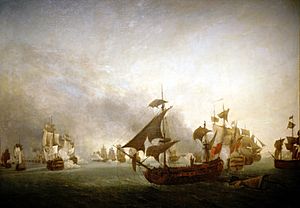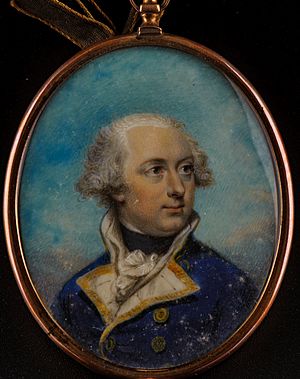Sir Charles Knowles, 2nd Baronet facts for kids
Quick facts for kids
Sir Charles Henry Knowles, Bt
|
|
|---|---|
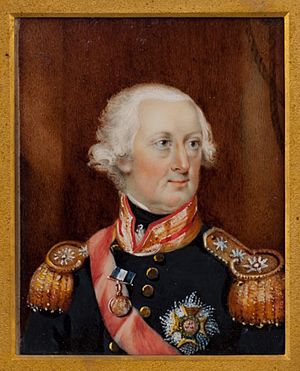 |
|
| Born | 24 August 1754 Kingston, Jamaica |
| Died | 28 November 1831 (aged 77) |
| Allegiance | United Kingdom of Great Britain and Ireland |
| Service/ |
Royal Navy |
| Years of service | 1768–1831 |
| Rank | Admiral |
| Commands held | HMS Supply HMS Minorca HMS Porcupine HMS San Miguel HMS Daedalus HMS Edgar HMS Goliath HMS Britannia |
| Battles/wars | Battle of St. Lucia Battle of Grenada Relief of Gibraltar Battle of Cape St Vincent |
| Awards | Naval Gold Medal Knight Grand Cross of the Order of the Bath |
| Relations | Charles Knowles (father) |
Sir Charles Henry Knowles, 2nd Baronet (born August 24, 1754 – died November 28, 1831) was a brave officer in the Royal Navy. He served during the American War of Independence, the French Revolutionary Wars, and the Napoleonic Wars. He eventually became an Admiral, a very high rank.
Knowles was a brilliant thinker and a great inventor of new naval tactics. He wrote several books about signals used between ships. He even got to try out his new ideas during his time at sea. Sometimes, he faced problems with discipline on his ships. This was often because many of his sailors were new and untrained. This might have caused issues in his relationship with his boss, Sir John Jervis. Their disagreements led to Knowles leaving active service after the Battle of Cape St Vincent. After that, he focused on studying naval issues.
Contents
Charles Henry Knowles was born in Kingston, Jamaica, on August 24, 1754. He was the second son of Admiral Sir Charles Knowles, who was the Governor of Jamaica. His mother was Maria Magdalena Theresa de Bouget.
Charles went to Eton College around 1764-1766. He then studied in Glasgow and Edinburgh. In 1768, he joined the navy as a midshipman. This was a rank for young officers in training. He served on the 36-gun frigate HMS Venus in the English Channel. Later, he was on other ships like HMS Lenox and HMS Southampton.
Serving in the West Indies
In 1773, Knowles became an acting-lieutenant on the sloop HMS Diligence. He served on several ships in the West Indies, including HMS Princess Amelia and HMS Guadeloupe. He also served on HMS Seaford near Cap Francois and Santo Domingo.
From 1774 to 1776, he was on the 50-gun HMS Antelope, which was the main ship for Rear-Admiral Clark Gayton. After that, he moved to HMS Squirrel. He served around Jamaica and the Mosquito Shore.
His rank was officially confirmed on May 28, 1776. He became a second lieutenant on the 28-gun HMS Boreas. He served on this ship in Port Royal and later near New York. He was promoted to first lieutenant in 1776. He then moved to the 50-gun HMS Chatham. This ship was the main ship for Vice-Admiral Molyneux Shuldham.
Knowles returned to Britain in January 1777 to see his sick father. While home, he published his first signal book. It was called A Set of Signals for a Fleet on a Plan Entirely New. This book suggested new ways to use numbered signals. It also proposed new tactics where ships would not stay in a straight line during battle. This was a very new idea for the time. Knowles believed his ideas influenced Lord Howe's tactics at the Glorious First of June battle. His father died on December 9, 1777, and Charles became the second baronet.
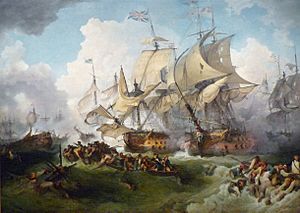
He returned to duty in summer 1778. He was with Barrington's fleet at the Battle of St. Lucia on December 15, 1778. He served on HMS Ceres. A few days later, the Ceres was captured by a French fleet. Knowles was exchanged as a prisoner. He then served as a lieutenant on HMS Prince of Wales. In July 1779, he was wounded during the Battle of Grenada. Knowles returned to England in October 1779. By December, he joined Admiral Sir George Rodney's main ship, HMS Sandwich. He volunteered for the Relief of Gibraltar.
Taking Command of Ships
On January 26, 1780, Rodney gave Knowles command of the 18-gun xebec HMS Minorca. Soon after, on February 2, he was promoted to post-captain. He then took command of the 24-gun HMS Porcupine. Knowles actively protected British trade in the Mediterranean Sea. He fought against privateers (private ships allowed to attack enemy ships) and guarded convoys.
At one point, he was stuck in Menorca and became ill. He managed to escape in January 1781. He was based in Gibraltar until he returned to England in April 1782. When he arrived, he was accused of serious crimes, but he proved his innocence. He went back to Gibraltar on HMS Britannia to command the Porcupine again. He became the most senior naval officer there. He returned to England once more, commanding the captured Spanish ship HMS San Miguel.
French Revolutionary Wars Service
After the war ended, Knowles continued his studies. He traveled in France in 1788. When the French Revolutionary Wars began in 1793, Knowles returned to active service. He commanded the 32-gun frigate HMS Daedalus. He was sent to Halifax, but also allowed to go to the Chesapeake Bay. A French convoy was planning to sail from there.
Knowles had trouble finding experienced sailors for his ship. He sailed from Portsmouth with a mostly new crew. But he trained them well by the time they reached Hampton Roads. Soon after he arrived, the French convoy sailed. Knowles watched them from the Daedalus. He sent this important information to Lord Howe. Howe then moved his fleet to stop the French, which led to the Glorious First of June battle. After his mission, Knowles sailed to Halifax and then returned to England.
He was then given command of the 74-gun HMS Edgar and served in the North Sea. Again, Knowles faced problems with his crew. The Edgar sailed with soldiers from many different army groups. Diseases like typhus spread quickly on the ship. When the ship returned to port, it had to be thoroughly cleaned. Knowles also had bad luck when the Edgar lost its masts in a storm. It had to be towed back to port.
In late 1795, Knowles moved to the 74-gun HMS Goliath. He served under Sir John Jervis in Lisbon. While there, he had problems with Jervis. In 1796, Jervis had him tried by a military court for not obeying a verbal order. But at the trial, Jervis's own captain said no order was given. The charge was dropped. This event seemed to start a strong dislike between Jervis and Knowles.
Battle of Cape St Vincent
Knowles was still commanding the Goliath in Jervis's fleet during the Battle of Cape St Vincent on February 14, 1797. During the battle, Jervis ordered his ships to turn one after another while fighting the enemy closely. Knowles followed the order. His ship came under heavy fire. The Goliath had to briefly leave the fight to fix its ropes and sails.
When he returned to the battle, Knowles saw a chance to sail past the Spanish ship Santísima Trinidad and make it lose wind in its sails. But Jervis signaled the Goliath and told Knowles to stop this move. The next morning, both Knowles on the Goliath and James Whitshed on HMS Namur saw that the Santísima Trinidad was in a weak position. They tried to signal this to Jervis, but he did not reply.
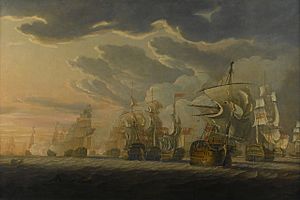
The fleet anchored in Lagos Bay the next day. Knowles placed the Goliath where it could protect the other ships. But when he went to Jervis's main ship, HMS Victory, Jervis told him the Goliath was in a dangerous spot. Knowles replied that the Spanish were unlikely to attack. That evening, Jervis sent his ship's master to move the Goliath. This was a great insult to Knowles. Jervis also ordered him to switch ships with Thomas Foley and take over HMS Britannia. Knowles soon returned to England after this, saying he was in poor health.
Later Life and Legacy
Knowles attended a special church service at St Paul's Cathedral on December 19, 1797. This service celebrated the victories at St Vincent and Camperdown. He received a Naval Gold Medal. After this, he mostly retired from public life.
He spent the rest of his life studying. He wrote seven books about naval topics. He also created a new code of signals in 1798. This was based on his earlier work from 1777. He was promoted to Rear-Admiral on February 14, 1799. He became a Vice-Admiral on April 24, 1804, and a full Admiral on July 31, 1810.
Knowles is thought to be one of the first people to suggest using aircraft for the navy. In 1803, he proposed using balloons from ships to watch French invasion forces. In 1830, he published his book Observations on Naval Tactics, which was largely about his own experiences.
He married Charlotte Johnstone on September 10, 1800. They had three sons and four daughters. He was made a Knight Grand Cross of the Order of the Bath on May 16, 1820, when King George IV became king.
Even with his difficult relationship with Jervis, sailors who served under Knowles respected him. One sailor who fought with him at the Battle of Cape St Vincent said, "Not a man on board but would have bled for Sir C. H. Knowles. He was as good a captain as I ever sailed with."
Admiral Charles Henry Knowles passed away on November 28, 1831, at age 77. His son, Francis Charles Knowles, became the next baronet.
See also
- Knowles Baronets


